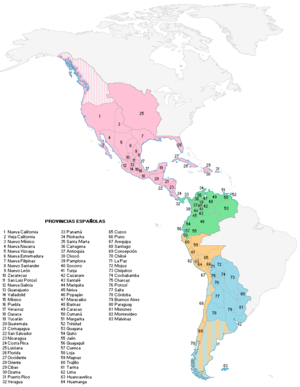Provincial deputation in Spanish America
Provincial deputation in Spanish America (1812-1814) - (1820-1823) |
|---|

The Provincial Deputation was created by the Spanish Constitution of 1812 to provide a representation of the territorial division of Spain and the American dominions of the Spanish monarchy during the term of the Constitution of Cadiz in the Courts of Cadiz. The constitutional provinces are listed in section ten.
The term "province" in America had an imprecise meaning. The American deputies with the word referred to the small province (Partido), while the European deputies did with great province (kingdom, viceroyalty). The Spanish courts identified province with Intendant.
The province was governed by a "Superior Political Chief" appointed by the King. With the absolutist restoration in Spain in 1814 and 1823, the provinces disappeared and its territory was again included in the restored viceroyalties.
American Provinces of Spain during Constitution of Cadiz of 1812
| Province | Capital |
|---|---|
| Nueva España | Mexico City |
| Provincias internas orientales | Monterrey |
| Provincias internas occidentales | Durango |
| San Luis Potosí | Guanajuato |
| Nueva Galicia | Guadalajara |
| Yucatán | Mérida |
| Guatemala (Guatemala, San Salvador, Honduras, Chiapas) | Guatemala |
| Nicaragua (Nicaragua, Costa Rica) | León |
| Cuba y las Floridas | La Habana |
| Puerto Rico | San Juan |
| Cuba | Santiago de Cuba |
| Santo Domingo | Santo Domingo |
| Venezuela | Caracas |
| Nueva Granada | Santa Fe |
| Quito | Quito |
| Lima | Lima |
| Cuzco | Cuzco |
| Chile | Santiago |
| Río de la Plata | Buenos Aires |
| Charcas | Chuquisaca |
